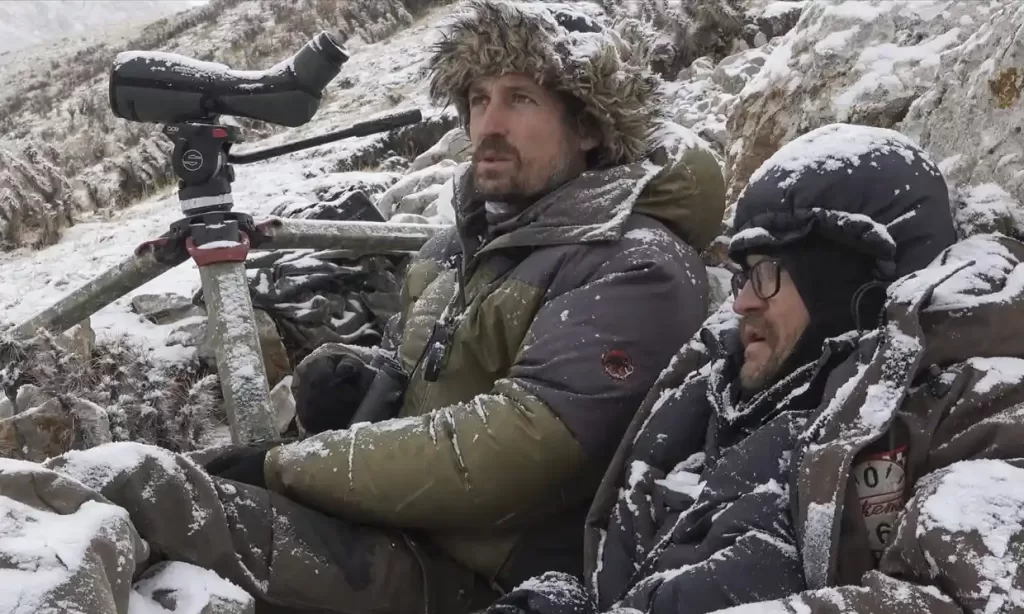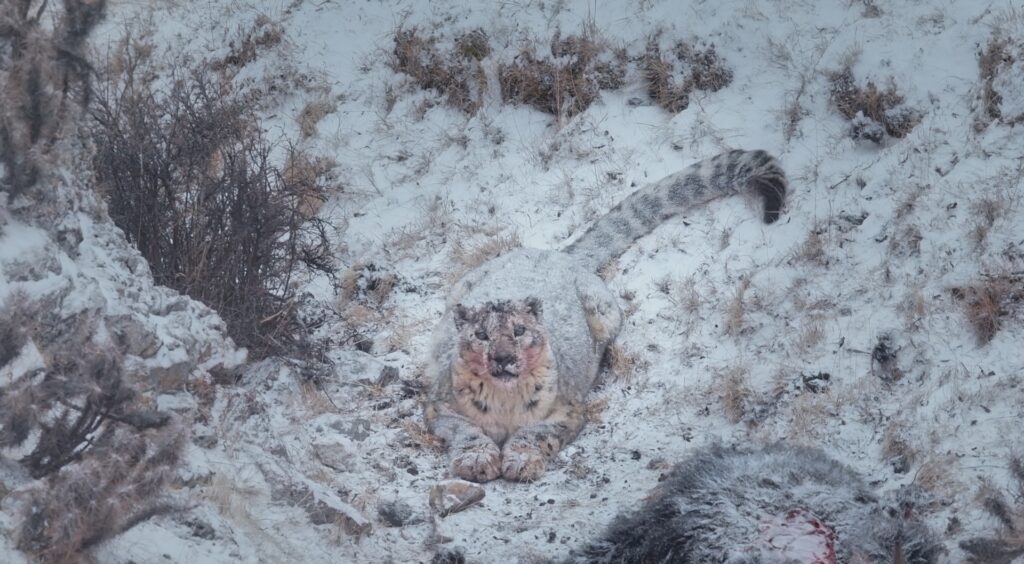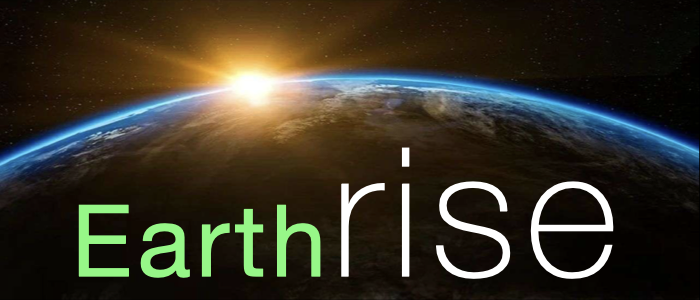||| EARTHRISE BY JAY KIMBALL |||
At the end of Marie Amiguet’s sublime observational documentary, The Velvet Queen, we are entranced by beautiful heart-tugging images of a Tibetan snow leopard. In an emotional voice-over, a poem is spoken by its author, Sylvain Tesson. The poem is an homage to the healing power of nature.
Tesson and renowned wildlife photographer Vincent Munier spent months hiking the vast, stark Tibetan highlands, hoping against hope, patiently searching for the legendary snow leopard.

To appreciate what lies beneath Tesson’s poem, we must understand how Tesson – a mental and physical wreck of a man – was drawn into this grueling journey.
Adventure and Misfortune
Long before his cathartic encounter with a snow leopard, Tesson had traveled the world and written tales of his hedonistic and rugged adventuring. Then, he suffered a humbling string of misfortunes – grief over the death of his mother; heartbreak over a former lover; and a grave injury that left him in a coma for weeks, with spinal damage, rib fragments in his heart, and half his face paralyzed.
New Yorker magazine writer Kathryn Schulz tells us what happens next:
Then one day, after he had learned to walk again, Vincent Munier appeared in his life and invited him on a trip to the Kunlun Mountains in Tibet to photograph snow leopards. Tesson expresses interest but also confusion; of the snow leopard, he says to Munier, “I thought it had disappeared.” “That’s what it wants you to think,” Munier replies.
The Journey of a Thousand Miles Begins with Each Step
It’s a mystery how Munier inspired Tesson to take on this arduous quest for the mythic cat. Tesson was a physical shadow of his former self. Renée Wilson, in her movie review of The Velvet Queen, helps us get into Tesson’s head as he physically and mentally struggles through each day of the trek:
We see Tesson’s annoyance at having to crouch down in below-zero temperatures for hours at a time, adjusting from “the modern frenzy of ‘everything, right now’ for the ‘probably nothing, ever’ of lying in wait.”
Each time Munier and Tesson find a promising spot, they set up a discreet camouflaged “hide” and sit in quiet repose. Bundled up against the Himalayan cold, perhaps they are fortified by the deep history of Tibetan stoicism and the Buddhist monastic spirit that permeates the region.
“Waiting is prayer,” Tesson says. For him, it became a restoring and contemplative journey into the heart of deep nature.
Tesson’s poem arises from this tender existential moment when he and Munier finally behold their elusive snow leopard. His words are a grace note to the film’s final images as this beautiful burly feline disappears into the night.

The Velvet Queen
I encountered the fine features of the spirit of the rocks.
Its image
slipped under my eyelids
and lived within me.
Closing my eyes, I saw its haughty feline face,
its features tapering into a delicate, terrible muzzle.
I’d seen the snow leopard.
I’d stolen fire
and I carried within me the embers.
I’d learned that patience was a supreme virtue.
The most elegant and most neglected.
It helped you love the world.
On the pages of my notebooks,
I compiled the principles inspired in me by these days
spent rubbing shoulders with beauty.
Revere what is in front of us.
Hope for nothing.
Delight in what crops up.
Have faith in poetry.
Be content with the world.
Fight
for it to remain.
Earthrise: A Climate Action Journal
This climate action journal offers information and actions we can take together, locally and globally, as we care for this precious Earth.
“The best way to heal a living system, is to connect it with more parts of itself.” ~ Margaret Wheatley
If you like what you read here, pass it forward to a few friends and ask them to do the same. Like a pebble tossed in a pond, the rings emanate outward, reflecting and growing exponentially. “Going exponential” is what it will take to reverse the climate extremes that are accelerating around us.
Thank you…
• Get an alert when there’s a new Earthrise post: Notify Me!
• Previous Earthrise posts: • First Light • Robert Dash – photographer, educator, environmentalist • Extreme Rain •
Notes
You can stream The Velvet Queen free through any library affiliated with Kanopy. Orcas Library Director Ingrid Mattson has helpful tips for how to access Kanopy:
Anyone with an Orcas Island Library card can access Kanopy (in addition to a number of other databases including one for e-books and audiobooks) for free. To get your library card, come in and ask at the front desk. Residents get free access, but the library even offers visitor cards for a small fee. Once you have your card, go to Kanopy, then “Add Your Library Card,” follow the next steps when prompted, and you’re all set. You can always call the library if you need help with your account or any of our databases: 360-376-4985. The library also offers thousands of DVDs (both movies and tv series) for checkout, and we love patron suggestions for what they’d like to see added to the collection.
The film closes with the haunting gentle voice of Nick Cave as he sings We Are Not Alone – the perfect grace note to this remarkable journey. In the video below we hear the songs accompanied by a gorgeous selection of images from the film.
The Art of Patience: Seeking the Snow Leopard in Tibet – An account of Sylvain Tesson trekking in Tibet with wildlife photographer Vincent Munier, in search of the snow leopard.
**If you are reading theOrcasonian for free, thank your fellow islanders. If you would like to support theOrcasonian CLICK HERE to set your modestly-priced, voluntary subscription. Otherwise, no worries; we’re happy to share with you.**









Thank you so much for such a beautiful and inspiring post.
“We are not alone.”
Truer words were never spoken.
Thank-you again, Jay.
Thanks for this, Jay.
Heartbreakingly beautiful. Thank you, Jay.
A Homeric journey into the wild and mysterious world of La Panthere des Neiges. Thank you for this wondrous story. Can’t wait to watch the movie.
Beautiful, as always—thank you , Jay!
Beautiful.
Thank you for the post and wonderful pictures and Nick Cave video, Jay. I’m struck by the close parallel to Peter Matthiessen’s book, “The Snow Leopard,” recounting his expedition to Nepal in search of the snow leopard while mourning the recent loss of his wife. We are alone / we are not alone.
‘Have faith in poetry.’ There’s a line to live by.
Thank you for bringing all this beauty to us, Jay
Deep thanks to you Jay for this.
The healing power of nature – from the elusive snow leopard to the beloved domestic felines, the mythic, quietly private, solitary life evokes the wonder, admiration, and respect for life’s paths, misfortunes, and choices on this ‘precious Earth.’ Waiting is also wonder. Thank You, Jay and Sue for introducing us to this film and the insights and emotion it kindled, and, for this Earthwise post.